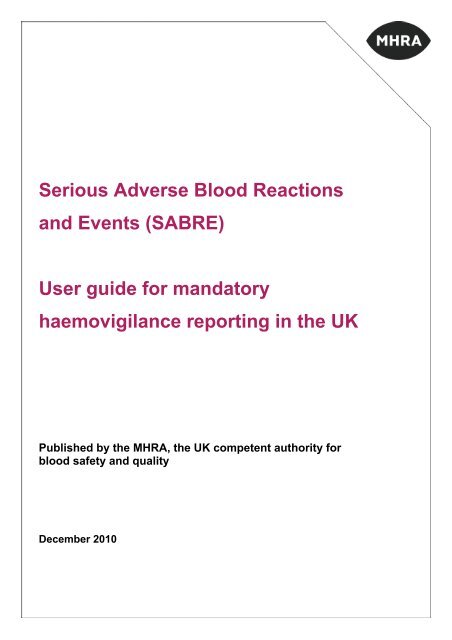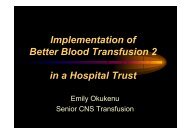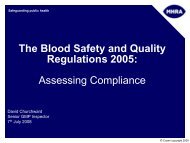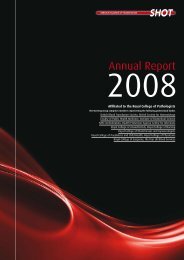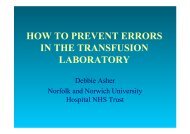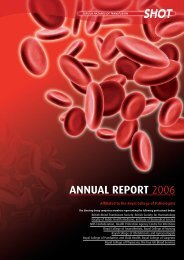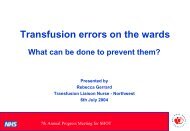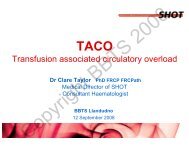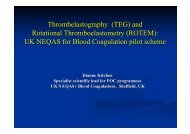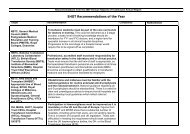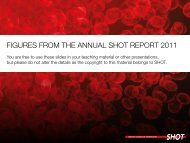SABRE â A user guide - Serious Hazards of Transfusion
SABRE â A user guide - Serious Hazards of Transfusion
SABRE â A user guide - Serious Hazards of Transfusion
You also want an ePaper? Increase the reach of your titles
YUMPU automatically turns print PDFs into web optimized ePapers that Google loves.
<strong>Serious</strong> Adverse Blood Reactionsand Events (<strong>SABRE</strong>)User <strong>guide</strong> for mandatoryhaemovigilance reporting in the UKPublished by the MHRA, the UK competent authority forblood safety and qualityDecember 2010
ContentsOverview..........................................................................................................41 WHY – the legal framework in the UK..........................................................41.1 UK legislation and the EU blood safety and quality directives ...........................41.2 Reporting to the MHRA ......................................................................................41.3 Annual summary reports ....................................................................................51.4 Annual haemovigilance fees ..............................................................................61.5 Confidentiality.....................................................................................................61.6 Reporting to SHOT (<strong>Serious</strong> <strong>Hazards</strong> Of <strong>Transfusion</strong>) ......................................72 WHAT – legal definitions and guidance .......................................................72.1 <strong>Serious</strong> adverse reactions (SAR).......................................................................72.2 <strong>Serious</strong> adverse events (SAE) ...........................................................................83 HOW – using the <strong>SABRE</strong> online reporting system....................................123.1 Help..................................................................................................................123.2 Registration ......................................................................................................123.2.1 Updating registration details .................................................................................. 123.3 Log in ...............................................................................................................133.4 Workspace .......................................................................................................133.4.1 Folder management............................................................................................... 133.4.2 Searching............................................................................................................... 143.4.3 Printing................................................................................................................... 143.5 Report source...................................................................................................143.5.1 Local incident reporting.......................................................................................... 143.5.2 SHOT accessibility................................................................................................. 143.5.3 Blood establishment notification ............................................................................ 153.5.4 Reporting adverse incidents involving medical devices ........................................ 153.5.5 Reporting adverse incidents relating to a licensed medicinal product................... 153.6 <strong>Serious</strong> adverse reactions................................................................................163.6.1 Notification report................................................................................................... 163.6.2 Reaction types ....................................................................................................... 173.6.3 Patient/donor information....................................................................................... 173.6.4 Confirmation report ................................................................................................ 173.6.5 Imputability levels................................................................................................... 183.7 <strong>Serious</strong> adverse events....................................................................................183.7.1 Notification report................................................................................................... 183.7.2 Event categorisation .............................................................................................. 193.7.3 Confirmation report ................................................................................................ 203.7.4 Root causes ........................................................................................................... 203.7.5 Corrective measures.............................................................................................. 203.7.6 Referral to the MHRA inspectors and the haemovigilance expert panel............... 203.8 Footnotes .........................................................................................................213.8.1 Attaching files......................................................................................................... 213.9 Saving/submitting reports.................................................................................213.9.1 Acknowledgements and reference numbers ......................................................... 213.10 Logging out ....................................................................................................214 Additional information ................................................................................224.1 Troubleshooting ...............................................................................................22MHRA <strong>SABRE</strong> <strong>user</strong> <strong>guide</strong> December 2010 2/30
Annex A ISBT table <strong>of</strong> reportable serious adverse reactions (SARs) ............23Annex B Table <strong>of</strong> reportable serious adverse events (SAE) ..........................25Annex C To report or not to report – worked examples .................................26References ....................................................................................................30MHRA <strong>SABRE</strong> <strong>user</strong> <strong>guide</strong> December 2010 3/30
OverviewThe Department <strong>of</strong> Health has designated the Medicines and Healthcare productsRegulatory Agency (MHRA) as the UK Competent Authority for blood safety. It is,therefore, the MHRA’s responsibility to ensure there is an accessible mechanism forthe reporting and recording <strong>of</strong> serious adverse blood reactions and events. T<strong>of</strong>acilitate this reporting requirement the MHRA has developed <strong>SABRE</strong>, an onlinesystem that allows the drafting, editing, saving and submission <strong>of</strong> notifications andsubsequent confirmations <strong>of</strong> blood related adverse events and adverse reactions.1 WHY – the legal framework in the UK1.1 UK legislation and the EU blood safety and quality directivesThe Blood Safety and Quality Regulations 2005 No. 50 [1] and the Blood Safety andQuality (Amendment) (No.2) Regulations 2005 No. 2898 [2] became effective for thepurposes <strong>of</strong> regulation in the United Kingdom (UK) on 08 November 2005. Theseregulations implement the requirements <strong>of</strong> the following European Union (EU)directives:• Directive 2002/98/EC [3] – setting standards <strong>of</strong> quality and safety for thecollection, testing, processing, storage and distribution <strong>of</strong> human blood andblood components• Directive 2004/33/EC [4] – regarding certain technical requirements for bloodand blood components.Two further technical directives were adopted by the European Commission on 30September 2005. These are:• Directive 2005/61/EC [5] regarding traceability requirements and notification<strong>of</strong> serious adverse reactions and events• Directive 2005/62/EC [6] regarding community standards and specificationsrelating to a quality system for blood establishments.These directives were transposed into UK legislation by the Blood Safety and Quality(Amendment) Regulations 2006 No. 2013 [7], which came into force on 31 August2006.The Blood Safety and Quality Regulations [7] apply to blood establishments and tohospital blood banks. The 2006 Amendment Regulations [7] introducerequirements for a quality system in blood establishments and hospital blood banks.They also extend traceability and record-keeping requirements to ‘facilities’ whichmay receive blood and blood components (care homes, independent clinics,hospitals and other NHS facilities and services, manufacturers <strong>of</strong> medicines andmedical devices and biomedical research.)1.2 Reporting to the MHRADirective 2005/61/EC [5] introduces the legal requirement for serious adversereactions (SARs) and serious adverse events (SAEs) occurring within EU memberstates to be reported to the relevant Competent Authority. The Department <strong>of</strong> Healthhas designated the MHRA as the UK Competent Authority. It is, therefore, theMHRA’s responsibility to provide a mechanism for the reporting and recording <strong>of</strong>MHRA <strong>SABRE</strong> <strong>user</strong> <strong>guide</strong> December 2010 4/30
these incidents. For this purpose the MHRA has developed the fully accessible onlinereporting system: <strong>SABRE</strong> (<strong>Serious</strong> Adverse Blood Reactions & Events).Haemovigilance comprises organised surveillance procedures relating to seriousadverse or unexpected events or reactions in blood donors or recipients, and theepidemiological follow-up <strong>of</strong> donors. The overall aim <strong>of</strong> this is to improve transfusionsafety. The UK was one <strong>of</strong> the first countries to implement such a system and since1996 the <strong>Serious</strong> <strong>Hazards</strong> <strong>of</strong> <strong>Transfusion</strong> (SHOT) scheme has successfullyundertaken those aspects <strong>of</strong> haemovigilance relating to recipients. Implementation <strong>of</strong>the Directive 2005/61/EC [5] with the mandatory requirement for reporting to theMHRA has provided an opportunity to strengthen and further develophaemovigilance in the UK.This document describes the requirements <strong>of</strong> the directives and also, in order toassist reporters <strong>of</strong> adverse events and reactions, includes guidance and flow chartsto help identify what constitutes a serious adverse reaction and a serious adverseevent and, therefore, what is or is not reportable to the Competent Authority (MHRA)under the Directive 2005/61/EC [5] and UK legislation [7]. However, this does notprovide a definitive list <strong>of</strong> what does and what does not constitute a reportableincident. You may also need to contact the MHRA for advice. As a general rule, incases <strong>of</strong> doubt, a report should be submitted.1.3 Annual summary reportsArticle 8 <strong>of</strong> Directive 2005/61/EC [5] and UK legislation [7] requires the CompetentAuthority to submit an annual report to the Commission, by 30 June <strong>of</strong> each year.The MHRA <strong>SABRE</strong> team will therefore ask each reporter to review and verify asummary <strong>of</strong> their reports for the preceding calendar year by the end <strong>of</strong> March thefollowing year. For example, we will ask you to verify the summary <strong>of</strong> your 2010reports by the end <strong>of</strong> March 2011. In order to provide an accurate record <strong>of</strong> overalltransfusion activity in the UK you will be asked to submit data in the format shown inthe table below.Report related to<strong>SABRE</strong> summaryreport confirmedas accurateYes/NoYes/NoYes/NoNumber <strong>of</strong>unitsissuedNumber <strong>of</strong>recipientsNumber <strong>of</strong>unitstransfusedWhole bloodRed blood cellsPlateletsPlasma (Including cryoprecipitate)Other (include granulocytes andbuffy coats, but not bloodproducts such as anti-D etc)EventsYes/NoYes/NoYes/NoNotesNumber <strong>of</strong> units issued = units distributed by blood establishments to the hospital blood banks+ units issued by blood establishments directly for transfusion.Number <strong>of</strong> recipients transfused = overall number <strong>of</strong> recipients transfused at least once over aperiod <strong>of</strong> one year.MHRA <strong>SABRE</strong> <strong>user</strong> <strong>guide</strong> December 2010 5/30
Number <strong>of</strong> units transfused = the total number <strong>of</strong> individual units transfused over thereporting period independent <strong>of</strong> the number <strong>of</strong> hospitalisation episodes but includinghome transfusions.1.4 Annual haemovigilance feesUnder the terms <strong>of</strong> The UK Blood Safety and Quality (Amendment) (No. 2)Regulations 2005 [2], paragraph (3B), the person who is responsible for themanagement <strong>of</strong> a hospital blood bank is required by law to ensure that the annualhaemovigilance fee is paid to the Finance Division <strong>of</strong> the MHRA (acting on behalf <strong>of</strong>the Secretary <strong>of</strong> State).Invoices are raised by the Finance Division <strong>of</strong> the MHRA and payment is requiredwithin 30 days.The fee payable is reviewed annually.Please note that a fee is payable for every blood bank within a trust. Where servicesare merged onto one central site it is important to advise us <strong>of</strong> this in writing so thatwe can ensure correct invoicing.1.5 ConfidentialityDirective 2005/61/EC [5] traceability requirements and consequent UK legislation [7]also require that identifying information on donors and recipients should be recordedby blood establishments and by those to whom the blood or blood components maybe delivered. However, this information is not required to be submitted to the MHRAas part <strong>of</strong> a notification or confirmation <strong>of</strong> a SAE or SAR. The link between anysubmitted report and the traceability records held by the reporting organisation will bemade through a local incident reference number that you associate with your reportand that you record on the report source section <strong>of</strong> the <strong>SABRE</strong> form. The localincident reference number can be any reference used to identify a report locally butmust not be the patient ID number, NHS number, donation number, donor number orany other reference that can be linked directly to personal details.Although <strong>SABRE</strong> provides a single starting point for reporting to both the MHRA andSHOT, the reporter is also able to choose to submit a report to only one organisation.Reports can be made in confidence i.e. a SHOT only report cannot be viewed by theMHRA. Similarly, the <strong>user</strong> must specify if MHRA reports are to be made available toSHOT for review.Any personal data that has been supplied in your registration or in your submittedreports <strong>of</strong> adverse events or reactions will be held on our database and will be usedin accordance with the Data Protection Act [8]. This could be for statistical analysis,management, planning or in the provision <strong>of</strong> services by the Agency. The MHRA willtreat all personal information as confidential. Whilst details <strong>of</strong> reported events orreactions may be disclosed, personal identifying details <strong>of</strong> patients and/or reporterswill not.Since 01 January 2005 the Freedom <strong>of</strong> Information Act [9] obliged the MHRA torespond to requests for information which it holds and is recorded in any form, andcreates a right <strong>of</strong> access to that information. The Agency will carefully consider itsobligations to <strong>SABRE</strong> reporters under the Act prior to any release or non-release <strong>of</strong>information.MHRA <strong>SABRE</strong> <strong>user</strong> <strong>guide</strong> December 2010 6/30
If you are concerned that, as a result <strong>of</strong> having disclosed information, you may bepenalised by your employer or that your actions may lead to your dismissal you maywish to consider whether the provisions <strong>of</strong> The Public Interest Disclosure Act(‘PIDA’) [10] will protect your employment position.PIDA protects workers who make a protected disclosure <strong>of</strong> information, concerningcertain types <strong>of</strong> matters relating to their employment, from being dismissed orpenalised by their employers as a result <strong>of</strong> the disclosure. The Act also has the effect<strong>of</strong> making confidentiality clauses unenforceable where there is a protecteddisclosure.1.6 Reporting to SHOT (<strong>Serious</strong> <strong>Hazards</strong> Of <strong>Transfusion</strong>)Reporting to SHOT remains voluntary, but is required for compliance withHSC/2007/001 ‘Better Blood <strong>Transfusion</strong>’ - safe and appropriate use <strong>of</strong> blood [11]and is a standard for the NHS Litigation Authority – CNST Clinical NegligenceScheme for Trusts in England [12].Active participation in <strong>SABRE</strong> and SHOT by all hospitals was recommended by thechief medical <strong>of</strong>ficer for England in his 2007 annual report. A number <strong>of</strong> blood safetyinitiatives depend on continuity <strong>of</strong> SHOT data for monitoring and evaluation and it istherefore important that reporters use the <strong>SABRE</strong> system to initiate a report to SHOTat the notification stage. Reporters should select either ‘Share this report with SHOT’or select the ‘SHOT only report’ box. <strong>SABRE</strong> will then prompt the SHOT Dendritedatabase to create a record for you and to send you an automated email link to thedatabase. You will then be asked to log in separately to the SHOT Dendrite systemand complete their online form.Please refer to the SHOT Dendrite database <strong>user</strong> manual for details <strong>of</strong> how and whatto report to SHOT. Alternatively, contact the SHOT <strong>of</strong>fice on 0161 423 4208.2 WHAT – legal definitions and guidance2.1 <strong>Serious</strong> adverse reactions (SAR)DefinitionsAll italicised quotes are from the UK legislation [7].A serious adverse reaction (SAR) is:‘an unintended response in a donor or in a patient that is associated with thecollection, or transfusion <strong>of</strong> blood or blood components that is fatal, life-threatening,disabling or incapacitating, or which results in or prolongs hospitalisation ormorbidity’‘blood establishments and the person responsible for the management <strong>of</strong> a hospitalblood bank shall notify the Secretary <strong>of</strong> State (Competent Authority) <strong>of</strong> any seriousadverse reactions observed during or after transfusion which may be attributable tothe quality or safety <strong>of</strong> blood or blood components –(i) collected, tested, processed, stored or distributed by the blood establishment, or(ii) issued for transfusion by the hospital blood bank’MHRA <strong>SABRE</strong> <strong>user</strong> <strong>guide</strong> December 2010 7/30
International Society <strong>of</strong> Blood <strong>Transfusion</strong> (ISBT) definitions, clinical andlaboratory features <strong>of</strong> reaction types.The table in Annex A reproduces the ISBT’s internationally agreed definitions <strong>of</strong> theserious adverse reactions terms listed in annex II, part D (annual notification formatfor serious adverse reactions) <strong>of</strong> Directive 2005/61/EC [5]. The use <strong>of</strong> ISBT termshas been agreed by a working party <strong>of</strong> the EU Commission and aims to facilitate thecomparison <strong>of</strong> the information sent to the Commission from all EU CompetentAuthorities.2.2 <strong>Serious</strong> adverse events (SAE)DefinitionsAll italicised quotes are from the UK legislation [7].A serious adverse event (SAE) is:‘Any untoward occurrence associated with the collection, testing, processing, storageand distribution, <strong>of</strong> blood or blood components that might lead to death or lifethreatening,disabling or incapacitating conditions for patients or which results in, orprolongs, hospitalisation or morbidity.’Reporting requirements‘Blood establishments shall notify… any serious adverse events related to thecollection, testing, processing, storage and distribution <strong>of</strong> blood or blood componentsby the blood establishment which may have an influence on their quality and safety,and;‘the person responsible for the management <strong>of</strong> a hospital blood bank shall notify…any serious adverse events related to the collection, testing, processing, storage anddistribution <strong>of</strong> blood or blood components by the hospital blood bank which may havean influence on their quality and safety,’Distribution‘the act <strong>of</strong> delivery <strong>of</strong> blood and blood components to other blood establishments ,hospital blood banks and manufacturers <strong>of</strong> blood and plasma derived products. Itdoes not include the issuing <strong>of</strong> blood or blood components for transfusion’The following terms, though used, are not defined in the Directive 2005/61/EC [5].Reporters in the UK should be <strong>guide</strong>d by the following definitions to help indetermining the need to report an SAE.‘Collection’ means the collection <strong>of</strong> whole blood or apheresis components from thedonor.‘Testing’ means the mandatory or discretionary testing <strong>of</strong> the donation by the bloodestablishment. It also includes tests done by the blood bank on processedcomponents or the recipient sample to determine compatibility.Note: for <strong>SABRE</strong> reporting the event category ‘testing <strong>of</strong> donations’ should only beused by blood establishments. For laboratory testing errors use the event category‘other’.‘Processing’ means manipulation <strong>of</strong> the blood donation or other blood componentsfor further manufacturing or subsequent administration to humans.MHRA <strong>SABRE</strong> <strong>user</strong> <strong>guide</strong> December 2010 8/30
Note: for <strong>SABRE</strong> reporting the event category ‘processing’ should only be used byblood establishments. For laboratory processing errors use the event category‘other’.‘Storage’ means safe management <strong>of</strong> the blood at all stages <strong>of</strong> the cold chain and isundertaken by blood establishments and also by hospital transfusion laboratories.Blood leaves the control <strong>of</strong> the hospital transfusion laboratory at the point where it isissued for transfusion or transferred to a satellite refrigerator that is not within thecontrol <strong>of</strong> the laboratory (it is arguable that all blood storage refrigerators should bewithin laboratory control).EU Commission definitions <strong>of</strong> reportable SAEsThe table in Annex B [link] provides examples <strong>of</strong> serious adverse events and howthey should be classified according to the proposed format in annex III, part C(Annual notification format for serious adverse events) <strong>of</strong> the Directive 2005/61/EC[5]. The use <strong>of</strong> these examples has been agreed by a working party <strong>of</strong> the EUCommission and aims to facilitate the comparison <strong>of</strong> the information sent to theCommission from all 28 Competent Authorities.The table in Annex C provides some worked examples <strong>of</strong> what is and is notreportable to the MHRA as an SAE.MHRA <strong>SABRE</strong> <strong>user</strong> <strong>guide</strong> December 2010 9/30
Figure 1 <strong>SABRE</strong> reporting flow chart for serious adverse reactions (SARs)Has there been a reaction in a recipientwhilst receiving blood or blood components?YesMight the reaction have been related to thequality and safety <strong>of</strong> the blood/bloodcomponent transfused?NoNo report requiredYesWas the reaction serious?i.e. fatal/life-threatening/disabling/incapacitating, resulting in or prolonginghospitalisation or morbidity ?NoReport to SHOT onlyYesSubmit notification report via <strong>SABRE</strong> as soon as known• Include components involved• Details <strong>of</strong> symptoms (in ‘Further Detail’)• Suspected reaction type (select from pick list)• Imputability (likelihood that the transfused component was the cause <strong>of</strong> the reaction)Indicate whether the blood establishment has been informed if suspected TTI or TRALIYesUndertake and complete local investigation(ideally within 30 days <strong>of</strong> notification)YesSubmit confirmation report• Verify details already submitted or amend as required• specify clinical outcome <strong>of</strong> the reaction (not the outcome for the patient)provide brief details <strong>of</strong> reasons for selection <strong>of</strong> imputability level.Note: Reports which are not confirmed and closed by the MHRA within 3 months <strong>of</strong>initial notification are likely to be referred to MHRA inspectors. If investigations arelikely to take more than 3 months then please ensure this is indicated via a footnote.MHRA <strong>SABRE</strong> <strong>user</strong> <strong>guide</strong> December 2010 10/30
Figure 2 <strong>SABRE</strong> reporting flow chart for serious adverse events (SAE)Has there been an adverse event which occurred within the organisation’s scope <strong>of</strong> responsibility as monitored by their quality management system?Was the adverse event associated with the collection, testing,processing, storage or distribution <strong>of</strong> blood or blood components, ormight it result in the provision <strong>of</strong> inappropriate components forclinical use?YesNoNot an SAE—local incident reportDid the quality systemhighlight the adverse event atthe time it was made?YesNoNoDid the quality systemhighlight the adverse eventlater on in the transfusionchain?YesWas the adverse eventdiscovered after issue?NoIs this an isolated adverseevent?NoIs this a repeated adverseevent which shows asignificant weakness in thequality system?No — discovered by chanceYesYesYesNoi) Might the adverse event have lead to death or life-threatening, disabling or incapacitating conditions or result in, or prolong hospitalisation or morbidity (even those notdirectly involved in the event)?ii) Did the adverse event result in the loss <strong>of</strong> rare or irreplaceable components, or the loss <strong>of</strong> a significant quantity <strong>of</strong> unmatched components?iii) Could the event seriously jeopardise the blood transfusion system?SAE – report to MHRA via <strong>SABRE</strong>Submit a Notification report via <strong>SABRE</strong> as soon as known- select the event type - where within the system the adverse event occurred- specify the type <strong>of</strong> error- state the implicated component- provide ‘further details’ as appropriateUndertake and complete local investigations and implement corrective measures (ideally within 30 days <strong>of</strong> notification)Submit confirmation report with details <strong>of</strong> root cause analysis and corrective measuresNOTE : Reports which are not confirmed and closed out by the MHRA within 3 months <strong>of</strong> initial Notification are likely to be referred to MHRA Inspectors. Ifinvestigations are likely to take more than 3 months then please ensure this is indicated via a Footnote.YesMHRA <strong>SABRE</strong> <strong>user</strong> <strong>guide</strong> December 2010 11/30
3 HOW – using the <strong>SABRE</strong> online reporting system<strong>SABRE</strong> can be accessed via the MHRA website: www.mhra.gov.uk. The system is secureand provides access only to registered <strong>user</strong>s. Once registered, <strong>user</strong>s have access to anelectronic report form and to a workspace containing a library <strong>of</strong> their previously draftedand/or submitted reports. Draft reports can be edited online and may have electronic files(e.g. images, documents) attached for submission.3.1 HelpOnline help is available at every stage and every level when using <strong>SABRE</strong>. Not only doesevery page (registration, log in etc) and every section <strong>of</strong> the report form have general helptext (accessed via a button at the top <strong>of</strong> the page), but each individual item on those pageshas its own help information (accessed by clicking the help icon adjacent to that item).Practical advice on the use <strong>of</strong> <strong>SABRE</strong> is available by email (sabre@mhra.gsi.gov.uk) or bytelephone from the <strong>SABRE</strong> Helpdesk on 020 3080 7336.3.2 RegistrationBefore using <strong>SABRE</strong> you must first register with the MHRA <strong>SABRE</strong> helpdesk.From your internet browser go to http://www.mhra.gov.uk and select the red ‘<strong>SABRE</strong> –Report an adverse blood reaction/event’ link on the right hand side <strong>of</strong> the screen.Registration is a simple process requiring the completion <strong>of</strong> a straightforward online formon which you are asked to provide basic details <strong>of</strong> who you are, the name and type <strong>of</strong>organisation that you work for, and how we can contact you. In this and the other sections<strong>of</strong> the form, there are certain fields that you must complete prior to submission. Thesemandatory fields are marked with a red asterisk.You are also asked to create and enter a password <strong>of</strong> your choice. This will be used eachtime you wish to log in to <strong>SABRE</strong>.When you have completed the registration form, just click the ‘submit’ button to send yourdetails to the <strong>SABRE</strong> helpdesk. A member <strong>of</strong> the <strong>SABRE</strong> team will then validate yourrequest and send you an email containing your registration number. In certaincircumstances staff on the helpdesk may wish to speak to you in person as part <strong>of</strong> thevalidation process.The MHRA anticipates that many reporters will continue to operate as part <strong>of</strong> ahaemovigilance team and may therefore choose to register using a shared email address.The MHRA recommends this approach. It will, however, still be possible for reporters toregister individually. For obvious reasons <strong>of</strong> security and confidentiality, we recommendthat you take care to ensure that your chosen password is carefully guarded within yourteam, but that it is accessible to more than one person so that reports can always be madeas soon as possible even in the event <strong>of</strong> sickness or absence <strong>of</strong> the main reporter.3.2.1 Updating registration detailsYou can change your password, email address, <strong>of</strong>fice address or telephone number.Simply log in to <strong>SABRE</strong> using your existing registration details and from your workspaceclick the ‘Update Registration’ button from the top navigation bar. Amend your details asnecessary and submit.MHRA <strong>SABRE</strong> <strong>user</strong> <strong>guide</strong> December 2010 12/30
If you change your email address, your original account will be temporarily suspendedpending validation <strong>of</strong> the new one by the <strong>SABRE</strong> team. Until the account has beenreactivated, you will not be able to log in using either your old details or your new ones.3.3 Log inSimply enter these three items and click ‘LogIn’• an email address (the one submitted on your registration request)• a registration number (sent to you by the MHRA <strong>SABRE</strong> helpdesk)• your password (chosen by you when registering).If you have forgotten your password then please call the <strong>SABRE</strong> helpdesk to have it reset.3.4 WorkspaceAfter successfully logging in, your workspace will be displayed.The workspace serves two primary functions:• as a searchable library <strong>of</strong> all your draft and submitted reports• as the platform from which you can> create a new report> open, read, and/or edit an existing report> search the content <strong>of</strong> all draft and submitted reports and their attachments> create folders so that you can organise and manage your reports.On your first visit your workspace will be empty. Each time you save a draft or submit areport (whether a notification or a confirmation, an event or a reaction, or a SHOT onlyreport) identifying details <strong>of</strong> that report will appear in the workspace.Your workspace is not visible to the MHRA or SHOT.The columns <strong>of</strong> summary information in the workspace are clearly labelled. The icons thatwill appear on the left hand side describe the type <strong>of</strong> report and its status. The iconscontain the letters N, C or S.N identifies a notification, C a confirmation, and S a SHOT only report.The yellow background colour indicates the report’s current status as draft, and the bluebackground indicates that you have submitted that report.There are columns containing key indentifying information from your notification andconfirmation, and a separate column to indicate, where relevant, the date you requested alink to SHOT.If you add a footnote to a submitted report, a letter F will also appear in that report’sworkspace record (see section 3.8 on footnotes).3.4.1 Folder management<strong>SABRE</strong> allows you to organise and store your reports in folders. You can create foldersand sub-folders using the folder manager option that is available from your workspace. Allfolders are displayed alphabetically. You can name and rename folders and also deletethem – although you cannot delete the reports they contain.MHRA <strong>SABRE</strong> <strong>user</strong> <strong>guide</strong> December 2010 13/30
You do not have to use the <strong>SABRE</strong> folders facility but, as the number <strong>of</strong> reports in yourworkspace increases, you may find that it will help you organise your workspace and makeit more manageable.There is an online help text for this section that will <strong>guide</strong> you through the creation andmanagement <strong>of</strong> folders. Further assistance can be obtained from the <strong>SABRE</strong> helpdesk.3.4.2 Searching<strong>SABRE</strong> incorporates an internal search facility that is accessible from the workspace. Thisallows you to search the content <strong>of</strong> all saved reports and questionnaires – whether theyhave been submitted or are still in draft form.3.4.3 PrintingEach section within <strong>SABRE</strong> includes a button at the top <strong>of</strong> the screen that enables you toaccess a ‘Printer Friendly Version’ <strong>of</strong> your form should you need a hard copy for your localrecords.If you encounter difficulties printing reports then this may be due to the version <strong>of</strong> InternetExplorer in use. We suggest you try using the File > Print option from your main tool bar oralternatively cut and paste the information into a separate Word document and then printthat.3.5 Report sourceMuch <strong>of</strong> this section <strong>of</strong> the report form will be pre-populated by <strong>SABRE</strong> with informationsubmitted on your registration form.The MHRA anticipates that many reporters will operate as part <strong>of</strong> a haemovigilance teamand that you may therefore choose to register using a shared email address. The MHRArecognises that in those circumstances the person completing a report form may not bethe registered <strong>SABRE</strong> <strong>user</strong>. For this reason the reporter name and email fields in thissection remain editable, i.e. if you are not the person in whose name the registration wasmade, you can enter your own name and contact details. This will ensure that anycommunications from the MHRA or SHOT are directed to the correct person.3.5.1 Local incident reportingYour local incident reference number is also required in this section. This (coupled with theMHRA reference number assigned upon submission <strong>of</strong> your completed report form) is vitalin avoiding potential confusion between incident reports. The local incident referencenumber can be any reference used to identify a report locally but must not be the patientID number, NHS number, donor number or any other reference that can be linked directlyto personal details.The MHRA is very keen to ensure that reporting to <strong>SABRE</strong> does not interfere with, orreplace, existing local reporting systems (e.g. local risk management reporting systems).To ensure that you are able to advise your colleagues promptly and clearly when yousubmit a report form, <strong>SABRE</strong> allows you to enter email addresses for report copies. Anyemail address correctly entered will receive an electronic copy <strong>of</strong> your report when youclick submit. You may find this useful for ensuring that colleagues, including local riskmanagers, clinical governance leads etc, are kept aware <strong>of</strong> your reports <strong>of</strong> such eventsand reactions. If more than one email address is entered, each must be separated by acomma.3.5.2 SHOT accessibilityMHRA <strong>SABRE</strong> <strong>user</strong> <strong>guide</strong> December 2010 14/30
You are also required to indicate whether you wish SHOT to have access to your report.MHRA recommends that you tick ‘Yes’. You will then be sent an email link to the SHOTDendrite database. However, please note that any additional details you submit in thisreport cannot be viewed by MHRA.In circumstances where the incident observed is not reportable to MHRA (e.g. clinicalerrors where a patient was not harmed), you should report to SHOT Only. If you tick thisbox you will be sent a link to the SHOT Dendrite database only and your report cannotbe viewed by MHRA.3.5.3 Blood establishment notificationAs well as indicating whether you have made a local report, you must also indicatewhether you have submitted a report to the relevant blood establishment. This is <strong>of</strong>particular importance in TTI (transfusion transmitted infections) and TRALI (transfusionrelated acute lung injury) cases, or in any other circumstances where it is possible that theblood establishment will have to take prompt action to ensure the safety <strong>of</strong> blood or bloodcomponents that have been distributed elsewhere.3.5.4 Reporting adverse incidents involving medical devicesReporters are also reminded that adverse incidents involving failures or problems withmedical devices (e.g. blood bags, syringes and needles, blood testing kits, refrigeratedblood storage, blood salvage devices, irradiators, etc.) should also be reported to theMHRA Adverse Incident Centre – preferably using the appropriate online system.Further information on this aspect <strong>of</strong> incident reporting may be obtained from the AdverseIncident Centre (telephone: 020 3080 7080) or from guidance documents on adverseincident reporting available on the MHRA website: www.mhra.gov.uk3.5.5 Reporting adverse incidents relating to a licensed medicinal productThe Yellow Card Scheme is run by the MHRA and the Commission on Human Medicines(CHM), and is used to collect information from health pr<strong>of</strong>essionals and the general publicon suspected side effects or adverse drug reactions (ADRs) to a medicine. Its continuedsuccess depends on the willingness <strong>of</strong> people to report suspected ADRs.We collect Yellow Card reports from anyone in the UK on both licensed and unlicensedmedicines including:• prescription medicines• blood products such as anti-D, IVIg and Octaplas• vaccines• over-the-counter (OTC) medicines• herbal remedies• swine flu antiviral medicines (Tamiflu or Relenza)• swine flu vaccines (Pandemrix, made by GSK or Celvapan, made by Baxter).The easiest and quickest way to report adverse drug reactions (ADRs) is tocomplete the electronic Yellow Card form on www.yellowcard.gov.uk. Fullinstructions for registering and completing the form are given on the website. You cankeep track <strong>of</strong> all the Yellow Cards that you send and easily submit updated information ifnecessary. Alternatively Yellow Cards are also available:• by downloading a pdf copy from our website to print out• by writing to: MHRA, CHM Freepost SW2991, London SW8 5BR• by emailing: pharmacovigilance@mhra.gsi.gov.uk• from the British National Formulary (BNF)• from the ABPI Medicines Compendium• from the MIMS Companion.MHRA <strong>SABRE</strong> <strong>user</strong> <strong>guide</strong> December 2010 15/30
3.6 <strong>Serious</strong> adverse reactions3.6.1 Notification reportThe first decision you have to make as a reporter is whether the incident you are reportingwas serious i.e. was it associated with the collection or transfusion <strong>of</strong> blood or bloodcomponents and was it fatal, life-threatening, disabling or incapacitating, or did it result inor prolong hospitalisation or morbidity.Then you need to decide if you are reporting a serious adverse event (SAR) or a seriousadverse reaction (SAE) – and to tick the appropriate box. If you tick event, then only theevent section will be accessible for completion.Similarly, if you tick reaction, only that section will be available. This and the localreference number comprise the minimum information that must be entered before you cansave a draft report.If you ticked serious adverse reaction (SAR) on the report source section, <strong>SABRE</strong> willautomatically allow you access to this section and the serious adverse event (SAE) sectionwill not be available. Your report will automatically be submitted as a notification onlyreport. If you already have all the information required to complete your report it is possibleto change the report type to notification and confirmation and submit both at the sametime.Notifications <strong>of</strong> SARs should be submitted to the MHRA as soon as possible.Confirmations should be submitted as soon as possible after you have collated all therequired information and your local investigation is complete. Where your report has beenmade available to SHOT, both the MHRA and SHOT recommend that you takeappropriate account <strong>of</strong> the SHOT analysis <strong>of</strong> the incident when concluding your localinvestigation. The MHRA will send email reminders to reporters where a confirmationreport has not been received within a reasonable time period. The time allowed will varyaccording to the nature <strong>of</strong> the reaction reported, but is generally one month.Remember – <strong>SABRE</strong> allows you to save reports in draft whilst you collect the informationrequired to complete all sections <strong>of</strong> the report form.The SAR section has been designed by the MHRA primarily to collect only that datarequired by the EU haemovigilance system. In order to collect this data in a consistentmanner suitable for summary analysis across Europe, standard picklists are provided for anumber <strong>of</strong> areas. You will be required to choose from these lists when reporting:• which blood component the serious adverse reaction is related to• type <strong>of</strong> serious adverse reaction• imputability level• clinical outcomeDonors For serious adverse reactions <strong>of</strong> a donor, the blood establishment must notify theCompetent Authority only where the quality and safety <strong>of</strong> the blood may be compromised.MHRA <strong>SABRE</strong> <strong>user</strong> <strong>guide</strong> December 2010 16/30
3.6.2 Reaction typesThese are:• Immunological haemolysis due to ABO incompatibility• Immunological haemolysis due to other allo-antibody• Non-immunological haemolysis• <strong>Transfusion</strong>-transmitted bacterial infection• Anaphylaxis / hypersensitivity• <strong>Transfusion</strong> related acute lung injury (TRALI)• <strong>Transfusion</strong>-transmitted viral infection (HBV)• <strong>Transfusion</strong>-transmitted viral infection (HCV)• <strong>Transfusion</strong>-transmitted viral infection (HIV-1/2)• <strong>Transfusion</strong>-transmitted viral infection, other (specify)• <strong>Transfusion</strong>-transmitted parasitical infection (Malaria)• <strong>Transfusion</strong>-transmitted parasitical infection, other (specify)• Post-transfusion purpura• Graft-versus host disease• Other serious reaction(s) – specify (e.g. transfusion associated circulatory overload(TACO), transfusion associated dyspnoea (TAD), febrile non-haemolytic reactions(FNHTR) and uncategorised unintended responses)NOTE: Please only select a reaction type from this list – listing symptoms is notappropriate in this field, but should be supplied under ‘Further details’ along with theresults <strong>of</strong> any follow-up tests undertaken as part <strong>of</strong> the transfusion reaction investigation.For ISBT definitions with clinical and laboratory features <strong>of</strong> reaction types pleasesee Annex A.3.6.3 Patient/donor informationAlthough some patient or donor information is required, this is only age and gender. Yourlocal records will, <strong>of</strong> course, require further detail for fulfilling traceability requirements.3.6.4 Confirmation reportWhen completing the confirmation section you must first indicate whether you are theperson that submitted the Notification. If not, you will be asked to enter your own nameand contact details.Next you must indicate whether your original assessment was correct: i.e. whichcomponent type was implicated, whether there was a serious adverse reaction andwhether that reaction was correctly described in the notification (and, if not, what thereaction actually was). You must also report the clinical outcome.Please note that this relates only to the clinical outcome <strong>of</strong> the reaction. Deathsassociated with a patient’s underlying condition or any other cause should not be included.Therefore, if the eventual outcome for the patient is death but the cause <strong>of</strong> death is notdue to the transfusion reaction, then the clinical outcome <strong>of</strong> the reaction is most likely to beeither complete recovery, minor sequelae or serious sequelae – please select an optionfrom the pick list.Death should only be selected as a reporting option where the patient failed to recoverfrom the transfusion reaction before dying. In these instances the imputability level willMHRA <strong>SABRE</strong> <strong>user</strong> <strong>guide</strong> December 2010 17/30
assign the likelihood that the reaction can be attributed to the transfused blood or bloodcomponent.If any associated components, products or reagents were required to be recalled and/orinvestigated as a result <strong>of</strong> the serious adverse reaction, the report should also includeexplicit reference to their fate and to any subsequent actions taken to ensure the futuresafety <strong>of</strong> the supply chain.Lastly, a further assessment <strong>of</strong> the imputability level is required, as your assessment mayhave altered following review <strong>of</strong> the results <strong>of</strong> your local investigation. Where the finalimputability level is 2 or 3, a report <strong>of</strong> your local investigation is required. Where theimputability level is considered to be
management system and may prompt referral to the MHRA’s Inspection, Enforcement andStandards Division.Remember – <strong>SABRE</strong> allows you to save reports in draft whilst you collect the informationrequired to complete all sections <strong>of</strong> the report form.The SAE section has been designed by the MHRA primarily to collect only the data thatare required by the EU haemovigilance system. In order to collect the data in a consistentmanner suitable for summary analysis across Europe, standard pick-lists are provided fora number <strong>of</strong> areas. You will be required to choose from these lists when reporting:• where within the system the serious adverse event occurred• specification <strong>of</strong> the serious adverse event .Clear definitions and explanations <strong>of</strong> all the terms used in this section <strong>of</strong> the form and inthe pick lists are available in the <strong>SABRE</strong> online help text.Annex B gives examples <strong>of</strong> serious adverse events and how they should be classifiedaccording to the proposed format in annex III, part C (annual notification format for seriousadverse events) <strong>of</strong> Directive 2005/61/EC [5].3.7.2 Event categorisationUnder the terms <strong>of</strong> Directive 2005/61/EC [5] the activities <strong>of</strong> hospital blood banks arelimited to storage, distribution (to external satellite sites only) and other (serious failures <strong>of</strong>the quality management system). Sites which process blood and blood components (e.g.irradiation process) will need to be registered as blood establishments and may also reportprocessing errors.The clinical act <strong>of</strong> transfusion is outside the scope <strong>of</strong> the Directive 2005/61/EC [5] whichapplies only up to the issue <strong>of</strong> the blood component for transfusion. Therefore a seriousadverse event occurring at the bedside before, during or after a transfusion (e.g.phlebotomy, administration <strong>of</strong> a blood component or use <strong>of</strong> an infected needle) is notreportable under the Directive 2005/61/EC [5].Based on the above, an SAE concerning ABO or other blood group incompatibility shouldbe reported only if it originates from: a mistake concerning blood or blood componentsexclusively for transfusion (i.e. not the intended recipient's blood sample collected byphlebotomy or finger sticks) and which occurred within the blood establishment or hospitalblood bank.SAEs that occur within the hospital blood bank scope <strong>of</strong> responsibility as monitored bytheir quality system (i.e. training <strong>of</strong> staff, security <strong>of</strong> equipment and premises, adherence topolicies and procedures) should be reported when one or more <strong>of</strong> the following criteriaapply:• inappropriate blood/blood components have been issued/distributed for clinicaluse, even if not used• the adverse event resulted in the loss <strong>of</strong> any irreplaceable autologous blood/bloodcomponent (e.g. rare blood group) or any highly matched (i.e. recipient specific)allogeneic blood/blood component• the adverse event resulted in the loss <strong>of</strong> a significant quantity <strong>of</strong> unmatched bloodor blood components• the adverse event could have implications for other patients or donors because <strong>of</strong>shared practices, services, supplies or donors (i.e. repeated event inside or outsidethe BE/HBB)MHRA <strong>SABRE</strong> <strong>user</strong> <strong>guide</strong> December 2010 19/30
• the adverse event could have a significant impact on the blood transfusion systeme.g. by jeopardising the confidence <strong>of</strong> blood donors or recipients in the system.Although there is a space for patient or donor information (age and gender) this is notmandatory as the blood or blood component involved may not have reached a patient. TheMHRA does not need or want patient or donor identifying information (e.g. patient/hospitalidentification number or name) to be reported on <strong>SABRE</strong>.3.7.3 Confirmation reportWhen completing the confirmation section you must first indicate whether you are theperson that submitted the notification. If not, you will be asked to enter your own name andcontact details.Next you must indicate whether your original assessment was correct i.e. whether therewas a serious adverse event and whether that event was correctly described in thenotification (and, if not, what the event actually was).3.7.4 Root causesYou must also provide what is described in the legislation as a ‘root cause analysis’. Whatthe MHRA requires here is simply details <strong>of</strong> the outcome <strong>of</strong> your local investigation into theSAE with evidence that as far as possible all root causes and contributory factors havebeen considered. This should help ensure that corrective and preventative measures aretargeted effectively.<strong>Serious</strong> adverse events are most frequently caused by human error. It is important thatyou do not report this as the root cause but investigate further into why the error was madee.g. distraction, recent process change, lack <strong>of</strong> knowledge/training, complexity <strong>of</strong> task etc.3.7.5 Corrective measuresFinally, you are required to provide details <strong>of</strong> any corrective measures and preventativeactions taken as a result <strong>of</strong> your investigation. Again you should provide information toexplain what immediate action has been taken to deal with the serious adverse event andthen explain what processes have subsequently been implemented to ensure that thesituation does not recur; e.g. an expired unit <strong>of</strong> blood has been discovered, recalled anddiscarded and in future units due to expire at midnight will be held in the laboratory stockfridge and will only be issued up to 8 pm for immediate use.3.7.6 Referral to the MHRA inspectors and the haemovigilance expert panelSome reports may be referred to the MHRA Inspection, Enforcement and Standardsdivision (IE&S) for further action where we are concerned that there may be a risk topatient safety e.g.• death due to ABO incompatible transfusion• multiple pre-transfusion testing errors• recurrent failures <strong>of</strong> the quality management system/ineffective corrective andpreventative actions• late reports• unusual recalls due to processing errors• persistent issuing <strong>of</strong> wrong components.Complex or unusual reports may be referred to the MHRA haemovigilance expert panel fortheir consideration and advice.MHRA <strong>SABRE</strong> <strong>user</strong> <strong>guide</strong> December 2010 20/30
3.8 FootnotesOnce you have submitted a completed report form, the submitted sections are assignedread only status – you can review them but you cannot alter the content. If, however, youwish to submit some additional comments or information that cannot wait until theconfirmation report is submitted, or if the confirmation report has already been submitted,then you may use the <strong>SABRE</strong> footnote facility. More than one footnote may be attached toa report. Attachments may also be made to footnotes.3.8.1 Attaching filesSeveral parts <strong>of</strong> the report form are mandatory fields – you are required to enterinformation (by typing or ‘pasting’) or to choose from a pick list. However, the MHRArecognises that where you are asked for ‘further details’, for details <strong>of</strong> your localinvestigation, for information on any corrective action taken, or for an imputability report - itmay be easier for you to attach a copy <strong>of</strong> an existing, locally produced, document.At each stage <strong>of</strong> the reporting process, whether you are preparing a notification or aconfirmation, <strong>SABRE</strong> allows you to attach a file to the form. This is done in the same wayas you would attach a file to an email: you can browse through the files on your localsystem, and then click to attach the one you wish to submit. You may also add adescriptive comment to clarify the nature <strong>of</strong> the file.3.9 Saving/submitting reportsWhen you have completed the notification and/or confirmation sections and you aresatisfied that all the information provided is both correct and complete, you should clicksubmit to send the report to the MHRA.3.9.1 Acknowledgements and reference numbersAs soon as you submit your completed report form, <strong>SABRE</strong> will provide you with anelectronic acknowledgement and an automatically generated, unique MHRA referencenumber. This number should be quoted in any correspondence or dialogue about yourreport, whether with the MHRA or with SHOT. The MHRA recommends that you crossreferencethe MHRA reference number with your local records.The reference number will appear in this format: 2010/011/008/HV1/001It shows, from left to right, the year, month and day that the report is submitted. This isfollowed by an indicator that the report was submitted online via <strong>SABRE</strong>, and a sequentialnumber for all reports submitted on that day.The reference number is automatically entered onto the saved report form and onto theworkspace listing, and is retained when a confirmation report is submitted. The samenumbering system is used for SHOT only reports.3.10 Logging outIt is important that you remember to log out after every session. Failing to log out maycause difficulties on the next occasion that you (or your colleagues) log in.MHRA <strong>SABRE</strong> <strong>user</strong> <strong>guide</strong> December 2010 21/30
4 Additional information4.1 TroubleshootingReports <strong>of</strong> serious adverse events and serious adverse reactions should only be submittedto the MHRA via <strong>SABRE</strong>.Other means <strong>of</strong> submission should only be considered if <strong>SABRE</strong> is temporarily unavailableand the report is urgent. In such cases the MHRA Adverse Incident Centre should becontacted for guidance on how to report.Enquiries, advice and feedbackMHRASHOTTel: 020 3080 7336 Tel: 0161 423 4208 Fax: 0161 251 4395email sabre@mhra.gsi.gov.uk email shot@nhsbt.nhs.ukMHRA <strong>SABRE</strong> <strong>user</strong> <strong>guide</strong> December 2010 22/30
Annex A ISBT table <strong>of</strong> reportable serious adverse reactions(SARs)Directive 2005/61/EC [5]categoriesImmunological Haemolysisdue to ABO incompatibilityImmunological Haemolysisdue to other allo-antibodyNOTE – Delayed serologictransfusion reactions(alloimmunisation) withoutclinical or laboratory signs <strong>of</strong>haemolysis are notreportable to <strong>SABRE</strong>.Non-immunologicalhaemolysis<strong>Transfusion</strong>-transmittedbacterial infection.Note – MUST be reported tothe supplying BloodEstablishment as soon aspossibleAnaphlaxis/hypersensitivityNOTE – minor allergicreactions which respondquickly to symptomatictreatment like anti-histamineor steroid medications areNOT reportable to <strong>SABRE</strong><strong>Transfusion</strong> related acutelung injury<strong>Transfusion</strong>-transmitted viralISBT DefinitionsClinical featuresFever, chills/rigors, facial flushing, chest pain,abdominal pain, back/flank pain,nausea/vomiting, diarrhoea, hypotension,pallor, jaundice, oligoanuria, diffuse bleeding,dark urine, decreased haemoglobin levels.Reactions may occur within 24 hours (acute)or may not manifest for up to 28 days(delayed)As above.As aboveFever, rigors and joint pain with no evidence<strong>of</strong> symptoms pre-transfusion or alternativesource <strong>of</strong> infection.Mucocutaneous signs and symptomsincluding urticaria, rash, pruritus, localisedangioedema, oedema <strong>of</strong> lips, tongue, uvulaand conjuctiva with airway compromise orsevere hypotension requiring vasopressortreatment (or associated symptoms likehypotonia, syncope). Respiratory symptomsmay be laryngeal (throat tightness,dysphagia, dysphonia, hoarseness, stridor) orpulmonary (dyspnoea, cough,wheezing/bronchospasm, hypoxemia)Usually occurs during or very shortly aftertransfusion.Hypoxaemia (PaO 2 /FiO 2 < 300 mm Hg or O 2sats
infection (HBV)<strong>Transfusion</strong>-transmitted viralinfection (HCV)<strong>Transfusion</strong>-transmitted viralinfection (HIV 1/2)<strong>Transfusion</strong>-transmitted viralinfection - other<strong>Transfusion</strong>-transmittedparasitical infection (Malaria)<strong>Transfusion</strong>-transmittedparasitical infection – Other,specifyNOTE: All suspected TTIsmust be reported to theBlood Services as a matter<strong>of</strong> urgency.Post transfusion purpuraGraft versus host diseaseOther serious reaction(s) -specifyBruising, severe haemorrhage, oozingwounds.Usually occurs 5-12 days post transfusion.Fever, rash, liver dysfunction, diarrhoea.Usually occurs 1-6 weeks after transfusion.E.g. Febrile non haemolytic transfusionreactions (FNHTR) where fever >= 39 ºC oralor equivalent and a change <strong>of</strong> >= 2 ºC frompretransfusion value, chills, rigors, headache,nausea. Usually occurs within 4 hours <strong>of</strong>transfusion and without any evidence <strong>of</strong>haemolysis, bacterial contamination orunderlying condition.E.g. <strong>Transfusion</strong> associated circulatoryoverload (TACO) – acute respiratory distress,tachycardia, increased blood pressure, acuteor worsening pulmonary oedema on frontalchest x-ray, evidence <strong>of</strong> positive fluidbalance.Usually occurs within 6 hours <strong>of</strong> completion <strong>of</strong>transfusion.E.g. <strong>Transfusion</strong> associated dyspnea (TAD) –respiratory distress occurring within 24 hours<strong>of</strong> transfusion but without the symptoms <strong>of</strong>TRALI, TACO or allergic reactions and notexplained by any underlying condition.evidence <strong>of</strong> infection posttransfusionand there was noevidence <strong>of</strong> infection prior totransfusion or any alternativesource <strong>of</strong> the infection, PLUSeither at least one componentreceived by the infectedrecipient was shown to containthe agent <strong>of</strong> infection or atleast one component receivedwas donated by a donor whohas evidence <strong>of</strong> the sametransmissible infection.As aboveAs aboveAs aboveAs aboveAs aboveThrombocytopenia (5-12 dayspost transfusion) and anti-HPAantibodies present.Pancytopenia, characteristichistological appearances onbone marrow biopsy, bonemarrow hypoplasia, chimerism.MHRA <strong>SABRE</strong> <strong>user</strong> <strong>guide</strong> December 2010 24/30
Annex B Table <strong>of</strong> reportable serious adverse events (SAE)<strong>Serious</strong> adverseevent, affectingquality and safety<strong>of</strong> bloodcomponent due toa deviation in:SpecificationProduct defect Equipment failure Human errorOther(specify)Definitions<strong>Serious</strong> adverseevent which is mainlylinked to a defect <strong>of</strong>the blood or bloodcomponents.Product defect:blood or bloodcomponent whichdoes not meet thequality and safetyrequirements set inannex V <strong>of</strong> theDirective 2004/33/EC[4], or which contain(remaining)contaminating agentsdespite screening,testing andprocessing havingbeen undertakenproperly (e.g.:product discardedafter positiveinfection test resultfollowing a windowperiod).Example: Clottingfactor rates notcompliant withspecifications forfresh frozen plasma.<strong>Serious</strong> adverse eventwhich is mainly linked to afailure <strong>of</strong> the equipment.Equipment: any materialused at any stage fromthe collection to thedistribution <strong>of</strong> blood andblood components, suchas whole blood collectionmachines, blood bags,aphaeresis kits andmachines, productionsets, reagents, test kits,bags for platelets orplasma storage, filters forleukocyte reduction,labelling machines, ITsystems, etc.Note: Failures <strong>of</strong> theequipment – whether ornot causing a <strong>Serious</strong>Adverse Event - shouldalso be reported underthe devices reportingprocedure (e.g. packcheck reveals a faultyseal and bag is discardedduring processing: not aSAE but should bereported under the devicereporting procedure).<strong>Serious</strong> adverse eventwhich is mainly linkedto a human error.Human error: Aninappropriate orundesirable humandecision or behaviourthat reduces, or hasthe potential forreducing,effectiveness, quality,safety, or systemperformance. It can bee.g. an omission:(forgetting to dosomething, or justleaving it out), acommission(performing an actincorrectly), a problemin sequence (rightaction, wrong order) ortiming (too fast or tooslow).Any seriousadverse eventwhich cannotbe classifiedin the alreadylistedspecifications.MHRA <strong>SABRE</strong> <strong>user</strong> <strong>guide</strong> December 2010 25/30
Annex C To report or not to report – worked examples* please note in the following examples, if a transfusion resulted in a serious transfusion reaction,these would be reported as SARs, regardless <strong>of</strong> whether it would have been an SAE or not.abcdEvent Decision Reasoning4 units <strong>of</strong> red cells were sentin a validated storagecontainer to a clinical area.The container has beenvalidated for 4 hours. The Not an SAEblood was subsequentlytransfused to a patient 5hours after the box wasopened.4 units <strong>of</strong> red cells were sentin a validated storagecontainer to a clinical area.The container has beenvalidated for 4 hours. Theblood was subsequentlytransfused to a patient 5hours after the box wasopened. This error has beenrepeated a number <strong>of</strong> times.4 units <strong>of</strong> red cells were sentin a validated storagecontainer to a clinical area.The container has beenvalidated for 4 hours, but theprocedure had beenmodified so that thecontainer should be returnedafter 2 hours. Despite areminder from the bloodbank to return the box after 4hours, the blood wassubsequently transfused to apatient 5 hours after the boxwas opened.4 units <strong>of</strong> red cells were sentin a validated storagecontainer to a clinical area.The container had beenvalidated for 4 hours, but theprocedure had beenmodified so that thecontainer should be returnedafter 2 hours. The bloodbank did not remind theclinical area to return theblood and it wassubsequently transfused to apatient 5 hours after the boxwas opened.Report asan SAENot an SAEReport asan SAEAlthough the error relates to the storage <strong>of</strong>the components, the error occurred in theclinical area. These errors are not covered bythe Blood Safety and Quality Regulations.However, since the process <strong>of</strong> sending bloodto the clinical areas is controlled by the bloodbank the local investigation should considerhow this can be improved.The act <strong>of</strong> transfusing the bloodinappropriately is still a clinical error and notreportable. However, the process <strong>of</strong>providing the blood to the clinical area iscontrolled by the blood bank. The process isnot robust enough to prevent inappropriatecomponents being transfused. Therefore thelack <strong>of</strong> a robust system is the adverse event.The adverse event is: associated withstorage; was not highlighted by the QS at thetime <strong>of</strong> the event; was discovered after theunits had been issued; and might have led toharm.The blood bank has carried out theirprocedure to the letter. The only error thathas occurred is clinical.Again, the act <strong>of</strong> transfusing theinappropriate blood is not the reportableadverse event. The failure <strong>of</strong> the blood bankto carry out their procedure ‘allowed’ theinappropriate blood to be transfused, and thisis the reportable adverse event. The adverseevent is: associated with the storage; was nothighlighted by the quality system; occurredafter the blood was issued; and might haveharmed the patient.MHRA <strong>SABRE</strong> <strong>user</strong> <strong>guide</strong> December 2010 26/30
efghiA sample was received inthe blood bank with thepatient’s name misspelled(sample and request formmismatch), but this wasdiscovered immediately andthe sample was rejected.A sample was received inthe blood bank with thepatient’s name misspelled(sample and request formmismatch), but this wasdiscovered when thecomponents were beinglabelled.A sample was received inthe blood bank with thepatient’s name misspelled(sample and request formmismatch), but this wasdiscovered when thecomponents were beinglabelled.This is the secondoccurrence within a month.A sample was received inthe blood bank with thepatient’s name misspelledon both form and sample. Itwas a new patient and theblood bank had no historicalrecords. The error was notspotted at the bedside untilafter the first unit had beentransfused.A sample was received inthe blood bank with thepatient’s name misspelled(sample and request formmismatch). The error shouldhave been spotted in theblood bank in accordancewith the local sampleacceptance protocol, butwas not discovered untilincorrectly labelled bloodwas at the bedside.Not an SAENot an SAENot an SAEunlessworkload issmallNot an SAEReport asan SAEThe blood bank quality system hashighlighted a clinical error. The clinical erroris not reportable.Although an adverse event occurred whenthe blood bank did not spot the incorrectlylabelled sample, the result is that it is not a‘serious’ adverse event. The adverse event:might result in the provision <strong>of</strong> inappropriatecomponents for clinical use; was nothighlighted at the time the adverse eventoccurred; was highlighted later on by thequality system; occurred before componentswere issued; is an isolated event, butbecause it was spotted before componentswere issued, would not have led to harm. Inthis example the adverse event is not seriousand is not reportable to THE MHRA.The reasoning is similar to example f, above.However, it is not an isolated event. So, inthis case a judgement needs to be made asto whether it is a repeated adverse event thatshows a significant weakness in the qualitysystem. Rather than concentrating on theabsolute number <strong>of</strong> adverse events, considerit in relation to the volume <strong>of</strong> samplesreceived in the blood bank. For a medium tolarge hospital with a medium to highworkload only 2 errors may not demonstratea significant and therefore, serious adverseevent. This should therefore be reported andmanaged locally. In a small or privatehospital where only tens <strong>of</strong> samples areprocessed in a week, the repeat error will bemore significant and should be reported.In this scenario, there are 2 clinical errors.Firstly, the sample was labelled incorrectlyand secondly, the bedside check was notproperly executed. Neither <strong>of</strong> these errorsare reportable as serious adverse events.The blood bank has followed theirprocedures and has not made any error.Although the error can be traced back to theclinical area, the reportable adverse event isthe blood bank error <strong>of</strong> not spotting theincorrectly labelled sample which led to aninappropriate component being provided.The adverse event: might result in theprovision <strong>of</strong> inappropriate components to theclinical area; was not highlighted at the timethe error was made; was highlighted bychance (i.e. not by blood bank qualitysystem); and might have harmed the patient.MHRA <strong>SABRE</strong> <strong>user</strong> <strong>guide</strong> December 2010 27/30
jklmnMidwife administers anti-D inerror to a patient who is RhpositiveA laboratory transcriptionerror has resulted in apregnant woman’s Rh groupbeing recorded as Rhnegative instead <strong>of</strong> Rhpositive. As a result anti-D isissued in error andhighlighted by the midwife.A patient was admitted toA&E and was incorrectlylinked to the patient record<strong>of</strong> a different person. Asample was taken andlabelled with the incorrectdetails and sent to the bloodbank. There were nohistorical records for thispatient and blood wasissued and transfused.A patient was admitted toA&E and was incorrectlylinked to the patient record<strong>of</strong> a different person. Asample was taken andlabelled with the incorrectdetails and sent to the bloodbank. There were historicalblood group records for thispatient, but the blood bankfailed to spot the bloodgroup mismatch, ignored thewarnings on the LIMSsystem and blood wasissued and transfused. Notransfusion reaction wasoccurred.A 2 unit crossmatch requestwas received in thelaboratory for a patient withanaemia. The request formindicated no other clinicaldetails or specialrequirements. This was anew patient and there wereno historical records. Nonirradiatedgroup specificunits were electronicallyissued and transfused.Not an SAE(report toSHOT)Report asan SAENot an SAEReport asan SAENot an SAEThe incident involves a clinical error inadministering a blood product. Clinical errorsare not reportable and blood products are notcovered by the Blood Safety and QualityRegulationsThe fact that the error has resulted in theissue <strong>of</strong> a blood product is irrelevant. In thiscase the adverse event is the blood bankincorrectly updating a patient record. Theadverse event: might result in the provisionon an inappropriate component (at anothertime); was not captured by the quality systemat the time the error was made; wasdiscovered by chance before a componentwas issued; and might have resulted in harmto a patient. In this scenario, even though theissue <strong>of</strong> Rh negative components to an Rhpositive patient would not have caused harm,the potential for harm still exists if the sameerror had been made but vice versa.This is a clinical/ administrative error and notcovered by the Blood Safety and QualityRegulations.Similar to l, above, the initial error occurred ina clinical area. However, the blood bank hasprocedures in place to highlight these errors,but they were not acted upon. Failure to carryout the procedure <strong>of</strong> checking historicalrecords is the adverse event. The adverseevent: might result in the provision <strong>of</strong>inappropriate components for clinical use;was not highlighted by the quality system atthe time <strong>of</strong> the event; was discovered afterthe issue <strong>of</strong> the components; and might haveresulted in harm to a patientThis is a clinical error as they omitted toinform the laboratory that the patient hadspecial requirements.Clinical errors are not covered by the BloodSafety and Quality Regulations.MHRA <strong>SABRE</strong> <strong>user</strong> <strong>guide</strong> December 2010 28/30
The laboratory wassubsequently advised thatthis patient had lymphomaand required irradiated bloodcomponents.oA 2 unit crossmatch requestwas received in thelaboratory. The request formindicated that the patient hadNHL and was being treatedwith Fludaribine, however nospecial requirements wereindicated. The laboratorySOP states that all patientswith these clinical detailsshould have a serologicalcrossmatch and be givenirradiated bloodcomponents. Non-irradiatedgroup specific units wereelectronically issued andtransfused.Report asan SAEAlthough there has been a clinical/adminerror in not completing the request formcorrectly, there has still been a failure <strong>of</strong> theQMS as the local SOP has not beenfollowed.This led to an inappropriate component beingissued and transfused. The adverse event:resulted in the provision <strong>of</strong> inappropriatecomponents to the clinical area; was nothighlighted at the time the error was made;was highlighted by chance (i.e. not by bloodbank quality system); and might haveharmed the patient.MHRA <strong>SABRE</strong> <strong>user</strong> <strong>guide</strong> December 2010 29/30
References1 Statutory Instrument 2005 No. 50 The Blood Safety and Quality Regulations 2005.ISBN 0 11 051622 2 http://www.legislation.gov.uk/uksi/2005/50/contents/made2 Statutory Instrument 2005 No. 2898 The Blood Safety and Quality (Amendment) (No.2)Regulations 2005 ISBN 0 11 073494 7http://www.legislation.gov.uk/uksi/2005/2898/contents/made3 Directive 2002/98/EC <strong>of</strong> the European Parliament and <strong>of</strong> the Council <strong>of</strong> 27 January 2003setting standards <strong>of</strong> quality and safety for the collection, testing, processing, storage anddistribution <strong>of</strong> human blood and blood components and amending Directive 2001/83/EC.OJ, L 33, 08.02.2003, p30.4 Commission Directive 2004/33/EC <strong>of</strong> 22 March 2004 implementing Directive 2002/98/EC<strong>of</strong> the European Parliament and <strong>of</strong> the Council as regards certain technical requirementsfor blood and blood components (Text with EEA relevance). OJ, L 91, 30.03.2004, p25.5 Commission Directive 2005/61/EC <strong>of</strong> 30 September 2005 implementing Directive2002/98/EC <strong>of</strong> the European Parliament and <strong>of</strong> the Council as regards traceabilityrequirements and notification <strong>of</strong> serious adverse reactions and events (Text with EEArelevance) OJ L 256 , 01/10/2005 P. 0032 – 0040.6 Commission Directive 2005/62/EC <strong>of</strong> 30 September 2005 implementing Directive2002/98/EC <strong>of</strong> the European Parliament and <strong>of</strong> the Council as regards Communitystandards and specifications relating to a quality system for blood establishments (Textwith EEA relevance). OJ L 256 , 01/10/2005 P. 0041 - 00487 Statutory Instrument 2006 No. 2013 The Blood Safety and Quality (Amendment)Regulations 2006 http://www.legislation.gov.uk/uksi/2006/2013/contents/made8 Data Protection Act 1998. ISBN 978-0105429982http://www.legislation.gov.uk/ukpga/1998/29/contents9 Freedom <strong>of</strong> Information Act 2000. ISBN 978-0105436003http://www.legislation.gov.uk/ukpga/2000/36/contents10 Public Interest Disclosure Act 1998.http://www.legislation.gov.uk/ukpga/1998/23/contents11 Department <strong>of</strong> Health. HSC 2007/001: Better blood transfusion - safe and appropriateuse <strong>of</strong> blood.http://www.dh.gov.uk/en/Publicationsandstatistics/Lettersandcirculars/Healthservicecirculars/DH_08061312 NHS Litigation Authority. Clinical Negligence Scheme for Trusts http://www.nhsla.com© Crown copyright 2010MHRA <strong>SABRE</strong> <strong>user</strong> <strong>guide</strong> December 2010 30/30


